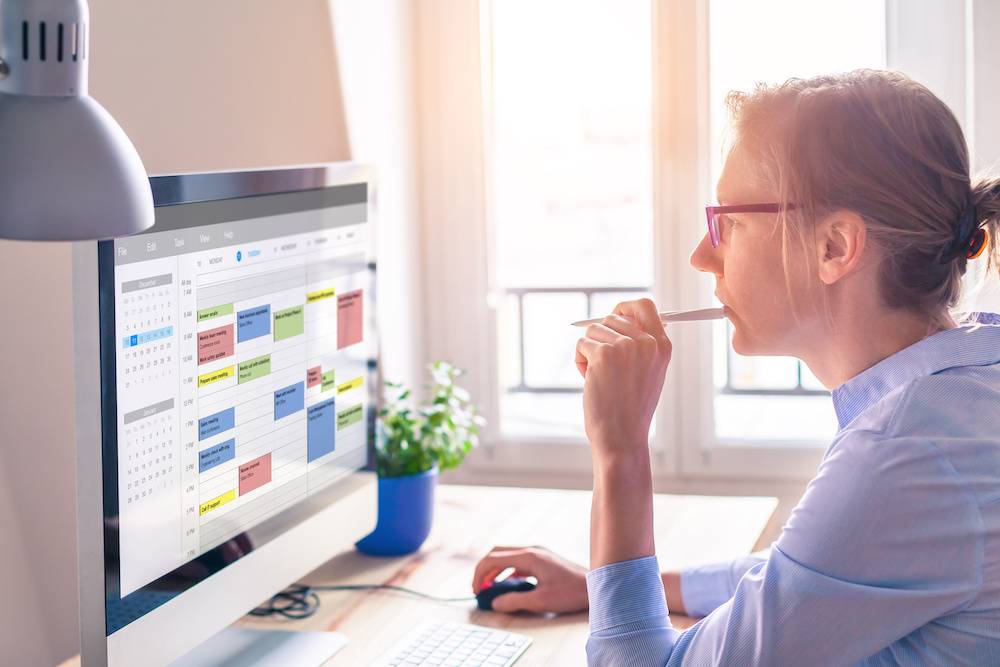Creating a productive work environment doesn’t have to be difficult – there are a few simple things you can do to make sure your workplace is conducive to getting things done. From setting up an efficient office layout to choosing the right office furniture, follow these tips and you’ll be well on your way to a hassle-free workspace.
Improving your Work Environment
Getting Organised
Keeping your work environment organised is key to creating a positive place to aid productivity. It’s so easy to let little gadgets and papers pile up on your desk, but organising them can make all the difference.
Always have a place for everything and keep your desk as clear as possible. Using things like charging stations, drawer dividers, label makers and folders can help keep things better organised and your work environment clear of clutter.
As well as keeping things clear, it’s important to make your work space your own, adding a few personal items has been shown to improve employee morale and so adding a plant or photo of loved ones to your desk space can help create a positive work environment.
Getting comfortable
Want to make sure you can stay productive throughout the day? Start by setting up a comfortable work area. Whether your office is at home or you commute to one every day, it’s important to make sure your furniture if comfortable and conducive to productivity.
Make sure your chair is at the right height and that it doesn’t give you back ache. Many people use standing desks which can be good to use also. As well as your seating (or standing!) arrangements. Natural light can make an office space a much nicer place to be, even if there aren’t windows providing sunlight near your work space there are bulbs etc. that can create a more natural lighting feel.
With so much time spent looking at screens it’s also important to have your laptop or computer keyboard at the right height and an anti-glare screen to help with tired eyes.
Your work environment is somewhere you spend a lot of time, so make sure it’s as comfortable as it can be. This can aid mental health as well as physical well being and it’s an area that is often overlooked.
Reduce distractions
Reducing distractions is a simple but effective way to create a productive work environment. Turn off any TVs in the workspace, close down social media tabs, and put your phone on silent so you can focus on work. If you have separate meetings rooms and you have a task that requires a lot of focus, see if you can book some time in one away from any interruptions.
There is software that you can use that literally ban you from accessing certain websites etc. for periods of time so that even if you do get tempted to check your Instagram profile you won’t be able to.
Take breaks
Taking a break every few hours isn’t just important for your productivity – it’s also crucial for your own physical and mental well-being. Whenever you’re feeling like you need some extra energy, getting up and taking a walk or doing a quick stretch will help get things going again.
Breaks give you the perfect opportunity to re-set and refocus, so don’t be afraid to step away from the task at hand for a little bit to give yourself the boost you need! it can actually boost productivity levels and this is why employers should encourage people to use break rooms or private spaces and ingrain into the company culture that taking breaks is an important part of any employees working day.
Make it fun
Creating a productive work environment doesn’t have to be all about the basics of organization, efficiency and collaboration. A great way to make it enjoyable is to inject some personal touches into it to avoid the office looking too clinical. Whether it’s adding some inspiring quotes, artwork or photo’s of the team or even the company’s mission statement graffiti style. There are lots of ways to make an office space more inviting and interesting, it helps with employee engagement to have positive work environments.
Mastering Time Management

We all know that managing our time effectively is an important tool in the toolbox, it helps reduce overwhelm and boosts productivity. It can also avoid things getting missed or work not being completed on time.
To Do Lists
The most basic type of time management strategy is the tried-and-true To Do list. This involves making a list of all the tasks you need to accomplish in a day, week, or month. The key to making an effective To Do list is to prioritise your tasks based on importance and urgency (e.g., “attend meeting with client” should be higher priority than “write blog post”). Once you have your list set up, it will be easier for you to focus on completing each task one at a time and crossing them off as they get done!
Time Blocking
Time Blocking is an effective way for those who want to stay organised while tackling multiple projects at once. It involves breaking down large chunks of work into smaller sections and allotting specific periods of time for each task or project (for example, 30 minutes dedicated solely to answering emails). By doing this, you can make sure that all projects are given equal attention instead of focusing too much on some while neglecting others. Plus, it keeps distractions at bay so that you can really buckle down and complete one task before moving onto the next!
Scheduling
Scheduling is another great way to stay organised. This strategy involves creating a daily schedule with specific times allocated for specific tasks or activities (e.g., 10am – 11am dedicated exclusively towards sales calls). Having an established schedule helps keep distractions at bay so that you can focus on what needs to get done without getting side-tracked by other obligations or responsibilities. Plus, having a plan beforehand allows you to see how much free time is available in between tasks so that you can use it wisely!
By having an office environment that promotes a healthy work life balance, includes some fun elements and encourages employees happiness and motivation by providing space for deep work, breaks and team meetings is a sure fire way to maintain a positive work environment and improve job satisfaction.
Any company’s success is dependent on the people that work there and so if your employees feel happy and engaged in their work environment, they will be far more motivated and productive. So whether you are a one-man band or a multinational corporation, having a positive work environment alongside using time management tools can help ensure continued success.

